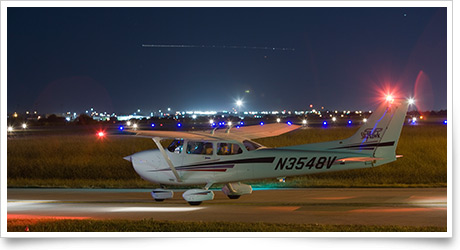training tipsLights for days and nights
What could be more startling than having a parked aircraft come to life just as you are passing by on the way to your own trainer? If no warning callout from the pilot is heard, and if no other indication such as a rotating beacon provides warning, you could find yourself uncomfortably close to that whirling propeller.
You wouldn’t want to be the pilot responsible for making pedestrians on the ramp jump. Avoiding that scenario means knowing the components of your aircraft’s lighting systems and using them to advance safety.
As a general rule, required equipment for day-VFR operation of small civil airplanes includes an approved anticollision light system, usually consisting of a rotating beacon, and possibly, strobe lights.
When must anticollision lights be on?
“Once that aircraft’s engine is started for the purpose of air navigation it is clear that FAR 91.209(b) requires that the aircraft’s anticollision lights be turned on,” wrote John Yodice in the September 2011 Pilot Counsel column. He added, “It is important to note that this interpretation addresses what is specifically required by the rule. The FAA is quick to offer a safety precaution. The FAA recommends, as a matter of safety, that the anticollision lights should be on before starting an engine or causing a propeller or rotor to move. That is a common practice among many pilots.”
For night VFR, approved position lights are also mandated. Position lights, explains the glossary of the Airplane Flying Handbook, are “lights on an aircraft consisting of a red light on the left wing, a green light on the right wing, and a white light on the tail.” Regulations “require that these lights be displayed in flight from sunset to sunrise.”
Many aircraft operators promote safety and give themselves a hedge against a dead aircraft battery by leaving their rotating beacon switch on when shutting down after a flight. If the pilot forgets to turn off the master switch, the continued operation of the rotating beacon could serve as a reminder. And at the next startup, the rotating beacon will begin to operate as soon as the master switch is turned on, alerting those nearby that the engine may soon come alive. Review Aeronautical Information Manual section 4-3-23 for a discussion of aircraft lighting systems operations, exceptions made in the interest of safety, and following manufacturers’ recommendations. training productsMyGoFlight unveils iPad Mini kneeboardThe new MyGoFlight iPad Kneeboard Folio, including clipboard, is a leather, rotating aviation kneeboard, lapboard, and everyday case for your iPad mini. The iPad is held by a form-fitting rotating cradle that your iPad simply clips into. All of the ports and controls remain accessible so the iPad can be charged, synced, and controlled when it is in its case. The cost is $159. ASA offers an instrument plotterASA’s instrument plotter features 12 scales for instrument charts, including a conversion scale for nautical and statute miles; holding patterns depicted for both standard and nonstandard entries; and compass roses allowing quick course and bearing information. The cost is $12.50.
Note: Products listed have not been evaluated by ePilot editors unless otherwise noted. AOPA assumes no responsibility for products or services listed or for claims or actions by manufacturers or vendors. final examQuestion: Can an aircraft stall at a normal cruise airspeed?
Answer: Yes, it can. If a wing exceeds the critical angle of attack, it will stall at any airspeed. FAA defines a stall as the rapid decrease in lift caused by the separation of airflow from the wing's surface brought on by exceeding the critical angle of attack. A stall can occur at any pitch or airspeed. The FAA gives an example in the Pilot's Handbook of Aeronautical Knowledge of an aircraft in a sharp dive at 100 knots when the pilot suddenly and sharply pulls back on the elevator control. Gravity and centrifugal force prevent an immediate alteration of the flight path, but the aircraft's angle of attack changes abruptly from quite low to very high. Since the flight path of the aircraft in relation to the oncoming air determines the direction of the relative wind, the angle of attack is suddenly increased, and the aircraft would reach the stalling angle at a speed much greater than the normal stall speed.
Got a question for our technical services staff? Email [email protected] or call the Pilot Information Center, 800/872-2672. Don’t forget the online archive of “Final Exam” questions and answers, searchable by keyword or topic. |



